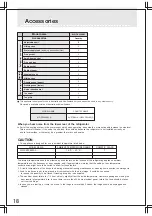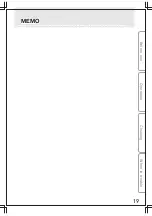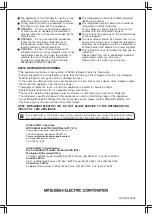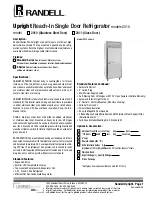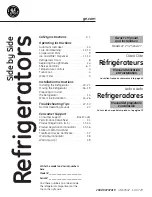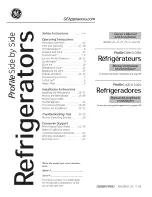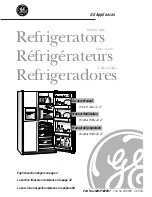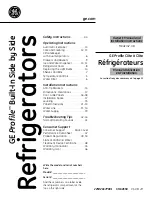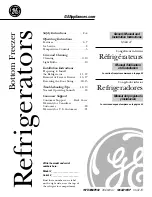
16
There is a loud sound.
The following sounds
do not mean there’s
a problem.
Troubleshooting
(continue)
Troubleshooting
(continue)
If this happens…
Please check this out.
Please do this. This is the reason.
It doesn’t make
ice at all. Water in
the tank doesn’t
decrease. It takes
too long to make
ice.
Water supply
tank/pipe has
frozen.
Ice cube is small
Ice cube stick
together.
Is it just a short time after
installation?
Are food items or the ice server
left in the water supply box?
Is the ice-maker in the “ICE MAKER OFF”
setting? (red light on.)
Are the water supply pump and pipe properly
attached to the water supply tank?
Is there enough water in the water
supply tank? Is the refrigerator tilted?
It takes about 12 hours to make the first batch of ice.
In the summer, it may take about 24 hours.
The ice-maker will judge that there is a lot of ice.
Please take food items, etc. out of the ice storage box.
Also, please level the ice evenly to the forefront.
Please turn off the “ICE MAKER OFF”
red light.
➡
Page 8, 10
Please place the outlet for the pipe inside
the tank correctly.
➡
Page 13
The number of ice cubes in one batch may be reduced.
Pour water into the water supply tank.
➡
Page 9
Automatic Ice-Maker
Sound
Did you attach water supply tank/pipe in
refrigerator compartment without any gaps?
Or, did you attach tank pipe in
water supply tank without any gaps?
Was the ice cube in the ice
storage corner for a long time?
Are you using mineral water to
make ice?
Did the surrounding items make
contact with the refrigerator?
The sound suddenly gets louder.
The sound changes.
When I open the door, there’s sometimes
a “krik” sound coming from the
inside, or a sound like water running.
Please check the attachment around water
supply tank. If there is a gap, cool air may
leak and water may freeze.
➡
Page 13
The ice cube will become small or stick together
if put in the ice storage corner for a long time.
We recommend you to stop ice-making
when not use the ice cube.
➡
Page 8
This is because there is a waterway that flows water
evenly into the ice-maker tray. Please do not fill water
above the “full line” mark on the water supply tank.
If ice is made with water that has a lot of mineral substances,
white sediment may form inside the cubes. It is harmless.
Please ensure there is a gap around items. It makes
sound when the refrigerator connects with the food items.
If it is right after installation, or hot out, or
if doors are open/closed often, it goes into
high-speed operation to chill with greater power.
This is the sound of the fan motor starting up.
There’s a “phyoon” sound when
I close the door.
This creaking sound occurs when warm air
enters and the plastic expands.
This is the sound of refrigerant (gas) flowing
through.
Sometimes there are sounds like “shuu”
or “plub-plub” (boiling water sound)
or “shaaa”(water flowing sound).
The ice has a white
sediment on it.
There are protrusions
on the ice. 2~3 cubes
get connected.
−
Clattering sound.
After plugging it in, there’s sometimes
a “gu” or “gween” sound (every
1~2 hours) when the ice-maker is off.
This is the auto ice-maker sound. Even if there’s no
water in the water supply tank, the auto ice-maker and
the pump will make a sound about every 100 minutes.
Sometimes there’s a “wheeen” or
“klik-klak” sound (every 1~2 hours).
This is the sound of the auto ice-maker
doing a operations check. Even when it is on
“ICE MAKER OFF” it will do the checking.
Doors open easily
Doors don’t close.
Is food or a case blocking the
door?
Is there food caught at the back
of the case of a drawer-door?
Is the electrical cord caught between
the body of the unit and the door?
Does the refrigerator wobble or
seem unstable?
Are the adjustable legs touching the floor?
Make sure again that you close
the doors properly.
Put away items properly so that they don’t
interfere when closing the door.
Remove the item. Please do not let food
items, the electrical cord, plastic bags, etc.
get in the way.
Bring the adjustable leg down, and raise
the front higher, with a slightly raised front,
closing doors becomes easier.
➡
Page 5
Please check “when alarm rings”,
“When alarm did not stop”.
➡
Page 8, 15
Alarm rings.
Doors

















